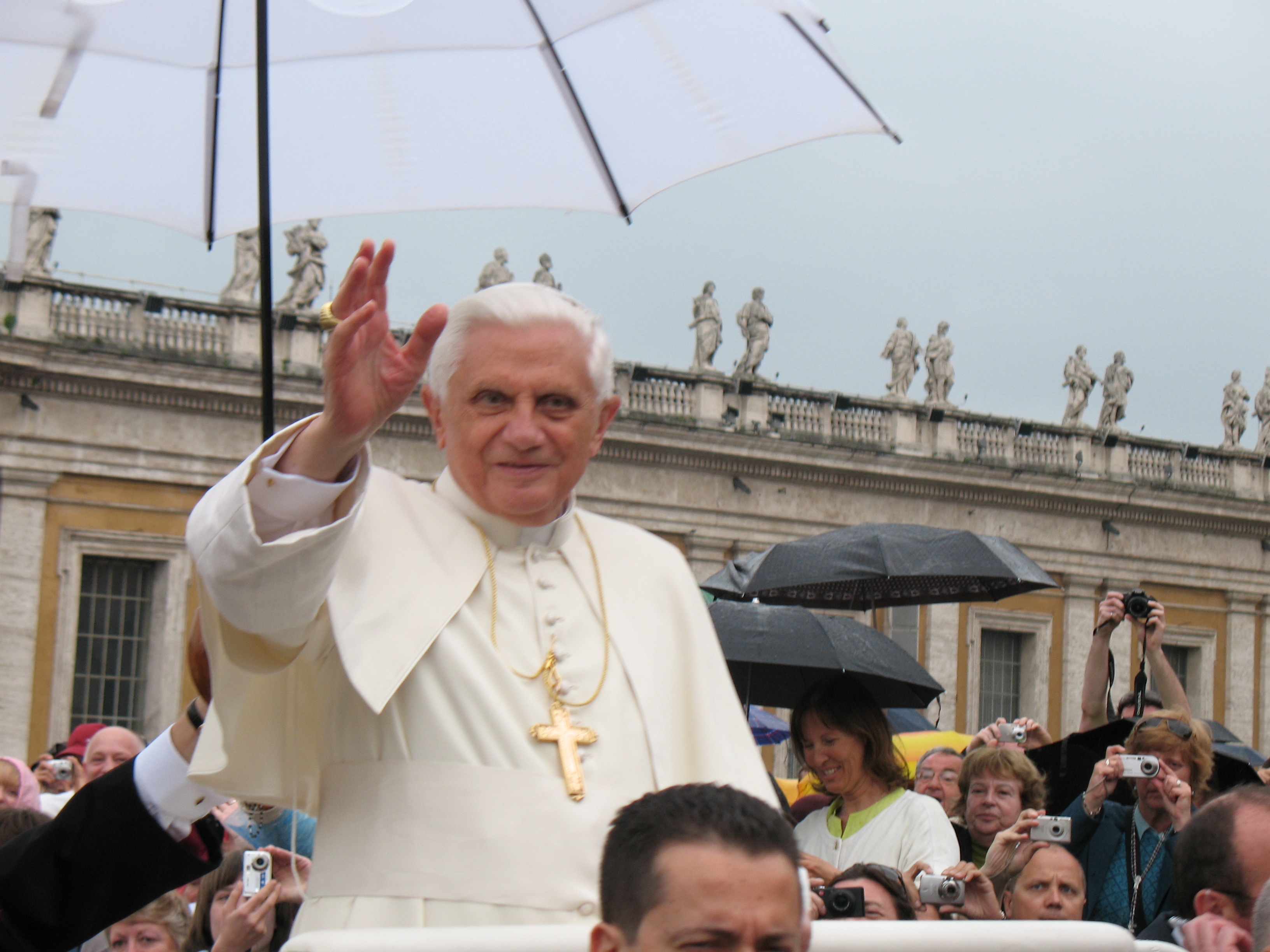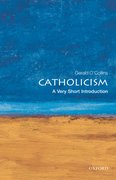By Gerald O’Collins, SJ
“Pope Benedict is 78 years of age. Father O’Collins, do you think he’ll resign at 80?” “Brian,” I said, “give him a chance. He hasn’t even started yet.” It was the afternoon of 19 April 2005, and I was high above St Peter’s Square standing on the BBC World TV platform with Brian Hanrahan. The senior cardinal deacon had just announced from the balcony of St Peter’s to a hundred thousand people gathered in the square: “Habemus Papam.” Cardinal Joseph Ratzinger had been elected pope.
Less than an hour earlier, white smoke pouring from a chimney poking up from the Sistine Chapel let the world know that the cardinal electors had chosen a successor to Pope John Paul II. The bells of Rome were supposed to ring out the news at once. But it took a quarter of an hour for them to chime in. When Hanrahan asked me why the bells hadn’t come in on cue, I pointed the finger at local inefficiency: “We’re in Italy, Brian.”
I was wrong. The keys to t he telephone that should have let someone contact the bellringers were in the pocket of the dean of the college of cardinals, Joseph Ratzinger. He had gone into a change room to put on his white papal attire, and didn’t hand over the keys until he came out dressed as pope.
he telephone that should have let someone contact the bellringers were in the pocket of the dean of the college of cardinals, Joseph Ratzinger. He had gone into a change room to put on his white papal attire, and didn’t hand over the keys until he came out dressed as pope.
One of the oldest cardinals ever to be elected pope, after less than eight years in office Benedict XVI has now bravely decided to retire or, to use the “correct” word, abdicate. His declining health has made him surrender his role as Bishop of Rome, successor of St Peter, and visible head of the Catholic Christendom. He no longer has the stamina to give the Church the leadership it deserves and needs.
Years ago an Irish lady, after watching Benedict’s predecessor in action, said to me: “He popes well.” You didn’t need to be a specialized Vatican watcher to notice how John Paul II and Benedict “poped” very differently.
A charismatic, photogenic, and media-savvy leader, John Paul II proved a global, political figure who did as much as anyone to end European Communism. He more or less died on camera, with thousands of young people holding candles as they prayed and wept for their papal friend dying in his dimly lit apartment above St Peter’s Square.
Now Benedict’s papacy ends very differently. He will not be laid out for several million people to file past his open coffin. His fisherman’s ring will not be ceremoniously broken. There will be no official nine days of mourning or funeral service attended by world leaders and followed on television or radio by several billion people. He will not be lifted high above the crowd like a Viking king, as his coffin is carried for burial into the Basilica of St Peter’s. The first pope to use a pacemaker will quietly walk off the world stage.
 In my latest book, an introduction to Catholicism, I naturally included a (smiling) picture of Pope Benedict. But he pales in comparison with the photos of John Paul II anointing and blessing the sick on a 1982 visit to the UK; meeting the Dalai Lama before going to pray for world peace in Assisi; in a prison cell visiting Mehmet Ali Agca, who had tried to assassinate him in May 1981; and hugging Mother Teresa of Calcutta after visiting one of her homes for the destitute and dying.
In my latest book, an introduction to Catholicism, I naturally included a (smiling) picture of Pope Benedict. But he pales in comparison with the photos of John Paul II anointing and blessing the sick on a 1982 visit to the UK; meeting the Dalai Lama before going to pray for world peace in Assisi; in a prison cell visiting Mehmet Ali Agca, who had tried to assassinate him in May 1981; and hugging Mother Teresa of Calcutta after visiting one of her homes for the destitute and dying.
Yet the bibliography of that introduction contains no book written by John Paul II either before or after he became pope. But it does contain the enduring classic by Joseph Ratzinger, Introduction to Christianity (originally published 1967). Both as pope and earlier, it was through the force of his ideas rather than the force of his personality that Benedict XVI exercised his leadership.
The public relations record of Pope Benedict was far from perfect. He will be remembered for quoting some dismissive remarks about Islam made by a Byzantine emperor. That 2006 speech in Regensburg led to riots and worse in the Muslim world. Many have forgotten his visit later that year to the Blue Mosque in Istanbul when he turned towards Mecca and joined his hosts in silent prayer.
Catholics and other Christians around the world hope now for a forward-looking pope who can offer fresh leadership and deal quickly with some crying needs like the ordination of married men and the return to the local churches of the decision-making that some Vatican offices have arrogated to themselves.
When he speaks at midday from his apartment to the people gathered in St Peter’s Square on 24 February, the last Sunday before his resignation kicks in, Pope Benedict will be making his final public appearance before the people of Rome. A vast crowd will have streamed in from the city and suburbs to thank him with their thunderous applause. They cherished the clear, straightforward language of his sermons and homilies, and admire him for what will prove the defining moment of his papacy—his courageous decision to resign and pass the baton to a much younger person.
Gerald O’Collins received his Ph.D. in 1968 at the University of Cambridge, where he was a research fellow at Pembroke College. From 1973-2006, he taught at the Gregorian University (Rome) where he was also dean of the theology faculty (1985-91). Alone or with others, he has published fifty books, including Catholicism: A Very Short Introduction and The Second Vatican Council on Other Religions. As well as receiving over the years numerous honorary doctorates and other awards, in 2006 he was created a Companion of the General Division of the Order of Australia (AC), the highest civil honour granted through the Australian government. Currently he is a research professor of theology at St Mary’s University College,Twickenham (UK).
The Very Short Introductions (VSI) series combines a small format with authoritative analysis and big ideas for hundreds of topic areas. Written by our expert authors, these books can change the way you think about the things that interest you and are the perfect introduction to subjects you previously knew nothing about. Grow your knowledge with OUPblog and the VSI series every Friday!
Subscribe to the OUPblog via email or RSS.
Subscribe to only VSI articles on the OUPblog via email or RSS.
Subscribe to only religion articles on the OUPblog via email or RSS.
Image Credits: Pope Benedict XVI during general audition By Tadeusz Górny, public domain via Wikimedia Commons; Church of the Carmine, Martina Franca, Apulia, Italy. Statues of Mother Teresa and Pope John Paul II By Tango7174, creative commons licence via Wikimedia Commons



For me he was not only the head of the Catholic Church but also an intellectual with an extensive knowledge of a variety of subjects and above all one of the greatest defenders of the protection of the environment who spoke openly about the threats such as global warming and other challenges we’ll have to face in the years to come. I live in a city whose inhabitants care a lot about the environment, famous for projects like the so-called Greenest City 2020 Action Plan whose aim is to eliminate the negative impact that our actions often have on the environment and I have to say Pope Benedict was never afraid to raise his voice to oppose the disastrous results of such actions. I think politicians could be inspired by his beliefs and ideas in this particular area and that’s why he will definitely be missed by many here in Canada.